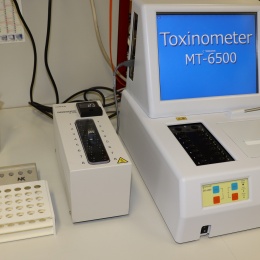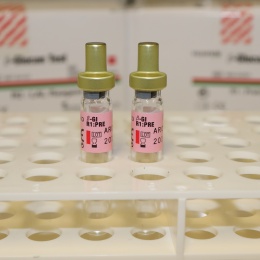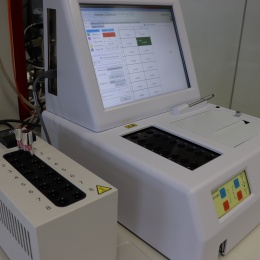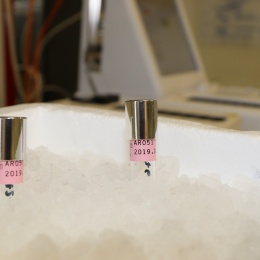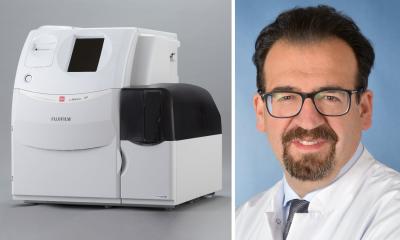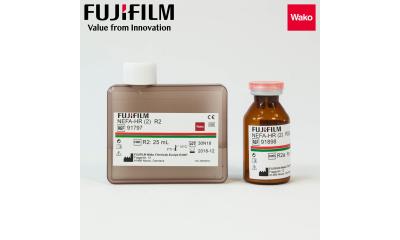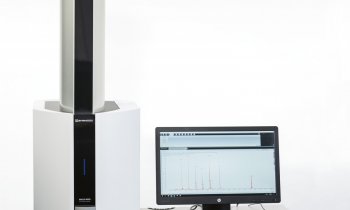Article • ß-D Glucan
New test for early fungal infection detection
At the National Reference Centre for Invasive Fungal Infections (Hans-Knöll Institute Jena) and the Institute for Hygiene and Microbiology, Würzburg University, Professor Oliver Kurzai and team utilise the fast and user-friendly β-D-Glucan Test, supplied by Fujifilm Wako Chemicals Europe GmbH, to check immunocompromised patients for signs of life-threatening, invasive fungal infections.
Invasive fungal infections are a significant health risk for immunocompromised patients. Beta-D-glucan is a marker that facilitates the early detection of these life-threatening fungal infections. The β-D-Glucan Test, developed by the diagnostics department at Fujifilm Wako, also aims to achieve fast (1 → 3) β-D-Glucan Test results for individual patient samples.

β-Glucan is a component of the fungal cell wall that circulates in the affected patients’ blood. The detection of β-Glucan therefore helps to diagnose fungal infections. The system has been available as a certified assay for measuring (1 → 3) β-D-Glucan in the serum or plasma since 28 December 2017, when the CE-mark was awarded. It is based on the LAL (limulus amebocyte lysate) cascade reactions, which can be measured in hospitals with a kinetic turbidimetric mono-test procedure.
During a year-long test phase carried out along with the University Hospital Würzburg, Kurzai has used the β-Glucan to monitor patients at risk of fungal infections caused by candida species, and also to detect infections caused by other fungal species. ‘The test also enables us to measure fungal infections in individual samples, relatively independent of the pathogens. With individual samples we can also determine very quickly if a patient is possibly suffering from a fungal infection or not,’ says Kurzai.
Blood sampling instead of invasive intervention
With many infections, be it sepsis caused by candida or pneumonia caused by pneumocystis, we know that the outcome worsens dramatically when the infection is not treated early enough
Oliver Kurzai
The test is particularly relevant for patients in intensive care. ‘Serious, invasive fungal infections are not that much of a problem in out-patient care,’ Kurzai added. Patients with life-threatening illnesses, such as severe neutropenia, or immunosuppressed patients who are developing pneumonia (such as HIV-positive patients) are at higher risk of infection.
The procedure can also be used to detect pneumocystis pneumonia in AIDS patients. ‘This test has considerable advantages for these patients as it can be carried out without invasive diagnostic procedures – a simple blood sample suffices for the β-Glucan Test,’ Kurzai said. Haematological patients at risk of invasive fungal infection of the lungs are tested for Galactomannan and β-Glucan – Galactomannan being a specific marker for aspergillosis. ‘With many infections, be it sepsis caused by candida or pneumonia caused by pneumocystis, we know that the outcome worsens dramatically when the infection is not treated early enough,’ he pointed out. ‘Scientific literature confirms that the window of opportunity where the right treatment must be given is just a few hours long.’
Fast precise diagnosis
‘With the new system, we usually receive the test result on the same day – within just a few hours – a big advantage for patients and for us: ‘The test helps us to decide on the right treatment quickly.’ Handling of the test is also very user-friendly, without long ‘hands-on time’. ‘Feedback from our laboratory is decidedly positive,’ Kurzai confirmed. ‘Training a medical laboratory technician can easily be carried out in a week or, at a push, in just two days.’
Up to now, the Institute for Hygiene in Würzburg had no procedure available to detect β-Glucan parameters. ‘This is why we used other diagnostic tests to rule out fungal infections, such as the detection of antibodies, or of certain antigens. These methods usually take longer, and studies show that the sensitivity and specificity is not as good as that of the β-Glucan Test. ‘Some of these procedures, which are still widely used, are so bad that they are not even recommended in the guidelines,’ Kurzai lamented.
Advantages and disadvantages
The preliminary evaluation of our data indicates that the β-Glucan Test is an important, additional option to improve the management of severely ill patients and risk patients
Oliver Kurzai
The detection of β-Glucan can be used as a screening test for fungal infections – many pathogenic fungi can lead to a positive test. ‘This can also be a disadvantage,’ Kurzai underlined. ‘If the test is positive, there is no certainty which type of fungal infection the patient is suffering from. Also, some types of fungi do not lead to raised levels of β-Glucan. A further disadvantage is that β-Glucan is found in numerous materials and infusion solutions, which means there’s a certain risk that the test generates a false positively result.’
Kurzai will continue to collate the parameters and data for the β-Glucan Test systematically at his Institute until the end of 2018. The first results are expected to be published in early 2019. ‘Our results so far don’t yet show how high the number of false positive results is for the procedure, which is something to keep in mind when interpreting the test results.’ However, Kurzai is sure of one thing: ‘The preliminary evaluation of our data indicates that the β-Glucan Test is an important, additional option to improve the management of severely ill patients and risk patients.’
Profile:
Oliver Kurzai heads the Institute for Hygiene and Microbiology at the University of Würzburg, as well as the Leibniz Institute for Natural Product Research and Infection Biology at the Hans Knöll Institute in Jena, where the National Reference Center is located under his leadership. From 2009 to 2016 he was Professor for Fungal Septomics, at the Friedrich Schiller University Jena. His research interests include infection biology and immunobiology of human-pathogenic fungi and infection biology and immunobiology of Neisseria meningitidis.
14.01.2019



